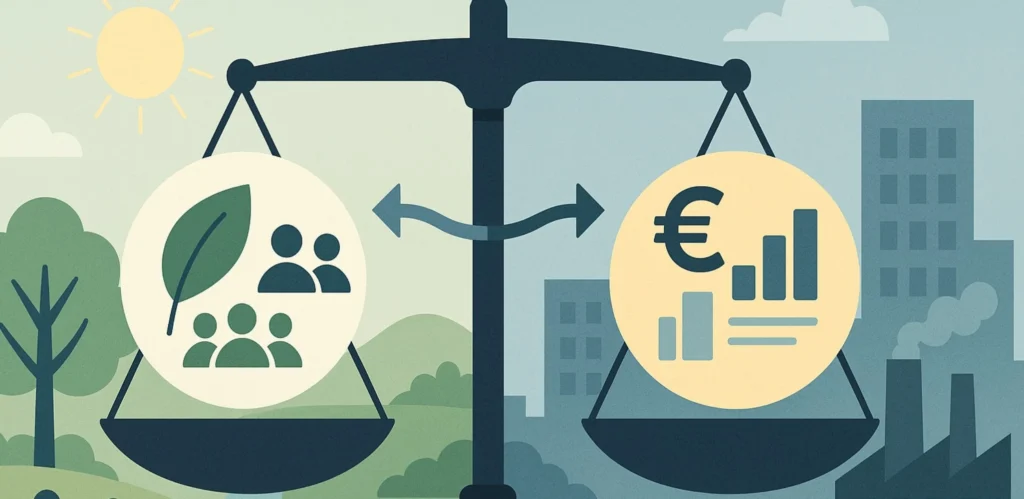Sostenibilità aziendale: un investimento che migliora ricavi, reputazione e accesso al credito

Negli ultimi anni, la sostenibilità aziendale è uscita dalla dimensione puramente etica per diventare una leva di crescita misurabile. Sempre più aziende che adottano strategie ESG registrano benefici tangibili: aumento dei ricavi, miglioramento della reputazione e condizioni di finanziamento più favorevoli. Un’indagine condotta nel marzo 2025 su scala nazionale lo conferma: le imprese che integrano […]
Due diligence: cosa cambia con il pacchetto Omnibus UE

Con la presentazione del pacchetto Omnibus, la Commissione Europea ha aggiornato una serie di normative per semplificare il quadro della sostenibilità aziendale. L’obiettivo: ridurre gli oneri amministrativi per le imprese, mantenendo gli impegni fondamentali in materia ambientale, sociale e di governance. Tra le aree toccate, una delle più significative riguarda la due diligence ai fini della […]
Doppia materialità: cos’è, perché è obbligatoria e come applicarla

La direttiva CSRD ha ridefinito le regole del gioco nella rendicontazione di sostenibilità.Tra i requisiti fondamentali c’è l’obbligo di adottare il principio della doppia materialità: un approccio che impone di guardare alla sostenibilità da due prospettive, e di costruire su questa base tutte le strategie, i report e le decisioni aziendali. Vediamo cosa significa nel […]
Il nuovo ecodesign europeo: progettare prodotti per durare

Quando si parla di sostenibilità, la fase di progettazione è sempre più centrale. Il nuovo Regolamento Ecodesign per prodotti sostenibili, accompagnato dal piano di lavoro 2025–2030 approvato dalla Commissione Europea, stabilisce criteri chiari: i prodotti immessi sul mercato dovranno essere pensati fin dall’inizio per essere più durevoli, riparabili, riutilizzabili e tracciabili. Si tratta di una serie […]
EUDR: non è solo una normativa. È un esame di maturità per le imprese

Dal 2025, le imprese che lavorano con cacao, legno, gomma, caffè, soia, palma da olio o bovini non possono più fare finta di niente. L’Europa chiede trasparenza. E la chiede per davvero. Non bastano più le dichiarazioni d’intenti, i bilanci impeccabili o le promesse sui social: con il Regolamento (UE) 2023/1115 – EUDR, ogni prodotto dovrà […]
Guida completa all’Ecolabel UE: vantaggi, categorie e procedura di certificazione

In un contesto in cui le promesse ambientali sono sempre più frequenti ma non sempre fondate, l’Ecolabel UE rappresenta un riferimento solido e affidabile per aziende e consumatori. È il marchio ufficiale dell’Unione Europea per i prodotti e servizi a ridotto impatto ambientale lungo tutto il ciclo di vita. Oggi, è uno degli strumenti più […]
Real-Time Monitoring of Industrial Production: The Heidelberg Materials Case

In un impianto industriale da centinaia di migliaia di tonnellate l’anno, sapere cosa si produce e quando non è un dettaglio: è la differenza tra controllo e incertezza, tra reattività e attesa. È da questa esigenza, concreta e urgente, che nasce la collaborazione tra Heidelberg Materials – uno dei principali player globali nei materiali da […]
Cultura del dato: il nuovo motore della strategia aziendale

Fino a pochi anni fa, parlare di dati ambientali significava fare riferimento a rendicontazioni tecniche, spesso confinate ai margini del bilancio. Oggi quei numeri assumono una nuova centralità. Non sono più allegati statici, ma strumenti dinamici capaci di orientare scelte, definire priorità e rafforzare la direzione strategica dell’impresa.La cultura del dato si impone così come […]
L’etica dei gesti invisibili: quando la cultura aziendale diventa motore del cambiamento

Ci sono rivoluzioni silenziose che non si annunciano. Si compiono. Nel lessico aziendale contemporaneo, la parola “sostenibilità” è ovunque. Ma ciò che fa davvero la differenza non è la sua frequenza, bensì la sua profondità. Una strategia ESG ben scritta non basta. Serve una cultura che sappia viverla. In un’epoca in cui ogni impresa è chiamata a […]
PMI e sostenibilità: come nasce un nuovo dialogo con le banche

Nel 2024 il Ministero dell’Economia e delle Finanze ha introdotto un documento che potrebbe segnare una svolta concreta nel modo in cui le piccole e medie imprese italiane dialogano con il sistema bancario: si tratta del “Documento per il dialogo di sostenibilità tra PMI e Banche”. Non una normativa, ma uno strumento operativo pensato per creare […]